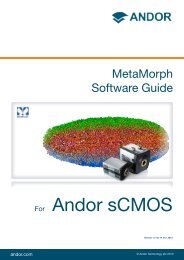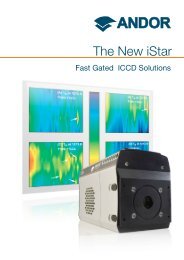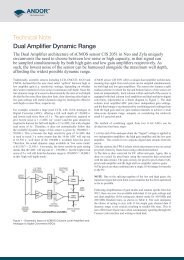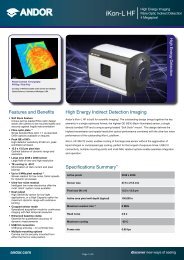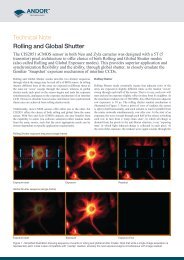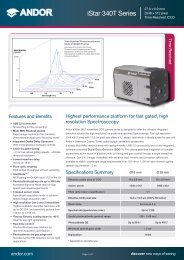Andor Luca R vs Interline CCD - Andor Technology
Andor Luca R vs Interline CCD - Andor Technology
Andor Luca R vs Interline CCD - Andor Technology
Create successful ePaper yourself
Turn your PDF publications into a flip-book with our unique Google optimized e-Paper software.
Technical Note<br />
External Use<br />
13-Dec-07<br />
<strong>Luca</strong>-R EM<strong>CCD</strong> <strong>vs</strong>. <strong>Interline</strong> <strong>CCD</strong><br />
for cell microscopy applications<br />
1.3 Mpix interline <strong>CCD</strong> <strong>Luca</strong> R EM<strong>CCD</strong><br />
Technical Note www.andor.com sales@andor.com Page 1 of 6
does <strong>Andor</strong>’s <strong>Luca</strong>-R EM<strong>CCD</strong> compare to well-established<br />
How<br />
<strong>CCD</strong> for microscopic imaging of cells?<br />
interline<br />
megapixel sensor format and small pixel size of <strong>Andor</strong>’s new <strong>Luca</strong> R EM<strong>CCD</strong> camera presents a novel<br />
The<br />
of ultra-sensitivity, resolution, field of view, and above all, flexibility. The EM gain feature of this<br />
combination<br />
offers the unique advantage to use the <strong>Luca</strong> R in light-starved conditions, in which current leading<br />
camera<br />
<strong>CCD</strong> sensors may not deliver optimal image quality.<br />
interline<br />
this case study we compared the sensitivity and resolution performance of the <strong>Luca</strong>-R against the highest<br />
In<br />
interline <strong>CCD</strong> on the market, in a cell microscopy application:<br />
specification<br />
<strong>Luca</strong> R EM<strong>CCD</strong> – 1 Megapixel EM<strong>CCD</strong> frame transfer sensor; 8x8 µm pixel size; < 1 e - read noise (with<br />
1.<br />
gain); 12.5 frames/sec (max.); -20 0 C cooling, USB 2.0 interface to PC.<br />
EM<br />
<strong>Interline</strong> <strong>CCD</strong> camera – Very common 1.3 megapixel interline <strong>CCD</strong> sensor; 6.45x6.45 µm pixel size;<br />
2.<br />
to deliver 5.5 e - read noise; 11 frames/sec (max.); -30 o C cooling; Firewire interface to PC.<br />
optimized<br />
Under low light imaging conditions, the <strong>Luca</strong>-R EM<strong>CCD</strong> convincingly outperforms the interline <strong>CCD</strong>,<br />
•<br />
much better signal contrast and, as a result, better resolution.<br />
delivering<br />
Under bright signal conditions, the interline <strong>CCD</strong> offers somewhat better image quality – this is due to the<br />
•<br />
dominant influence of smaller pixel size.<br />
now<br />
Even under conditions of ‘moderate’ intensity, better spatial resolution can be achieved from higher<br />
•<br />
EM<strong>CCD</strong>, despite larger pixels. This is afforded through enhanced contrast between signal and<br />
sensitivity<br />
1 1.3 MPix interline <strong>CCD</strong> <strong>vs</strong>. <strong>Luca</strong>-R EM<strong>CCD</strong> under low light imaging conditions. 100 ms exposure time was used and 10% of<br />
Figure -<br />
–<br />
power (approx. 2 mW at 488nm) illuminated the sample. Read noise of the interline camera is 5.5 e rms (i.e. up to ~ 20e<br />
laser available<br />
Each camera comparably offers > 60% QE at the test emission wavelength:<br />
We demonstrate that:<br />
background noise, thus better definition of fine structural features.<br />
1.3 Mpix interline <strong>CCD</strong> <strong>Luca</strong> R EM<strong>CCD</strong><br />
peak-to-peak) and is dominant in that image. Note that the images are rotated slightly relative to each other.<br />
Technical Note www.andor.com sales@andor.com Page 2 of 6
microscopy on living cells will at some stage ultimately push the user to low-light conditions, then the<br />
Since<br />
of the <strong>Luca</strong> R to operate well under bright conditions, and extremely well under low light<br />
flexibility<br />
R and <strong>CCD</strong> X were compared on an inverted microscope using confocal illumination through a spinning disk<br />
<strong>Luca</strong><br />
(CSU-22, Yokogawa) to test sensitivity performance and resolution under different signal strength conditions.<br />
unit<br />
laser excitation was employed and the fluorescence of a green emitting fluorophore was detected from a<br />
488nm<br />
Bovine fixed immunofluorescent cell sample (Invitrogen). A x60 objective lens (oil. NA 1.42) was used<br />
standard<br />
two cameras were compared across a range of illumination intensities, repeated over a number of cells. All<br />
These<br />
were designed to weight both cameras’ performance in terms of signal-to-noise, spatial resolution and their<br />
tests<br />
on fluorescence microscopy applications.<br />
impact<br />
the series of tests, both cameras were subject to measurements in the following light conditions:<br />
In<br />
Low-light conditions (short exposure and/or low laser power), typical of demands<br />
1.<br />
by live cell measurement.<br />
imposed<br />
2 1.3 MPix interline camera <strong>vs</strong>. <strong>Luca</strong>-R under higher signal conditions. Signal intensity during this test was 40x higher<br />
Figure -<br />
–<br />
in Figure 1. The 5.5 e rms of the interline <strong>CCD</strong> is much less of a factor, and the smaller pixel size now afford<br />
used than<br />
somewhat higher resolution image compared to the EM<strong>CCD</strong> <strong>Luca</strong> R.<br />
a<br />
.<br />
IMPLICATION FOR LIVE CELL IMAGING<br />
conditions makes it the better choice for live cell work in general.<br />
Test conditions<br />
with additional x1.2 magnification between microscope and the camera.<br />
2. Light-rich conditions (longer exposures and/or higher laser power).<br />
3. Intermediate signal, i.e falling between conditions 1. and 2.<br />
1.3 Mpix interline <strong>CCD</strong> <strong>Luca</strong> R EM<strong>CCD</strong><br />
Technical Note www.andor.com sales@andor.com Page 3 of 6
Results<br />
Under restricted signal conditions, derived through use of low laser power and/or short exposures, the <strong>Luca</strong> R<br />
significantly out-performed the interline <strong>CCD</strong> sensor, both in terms of Signal-to-Noise and resolution (because the<br />
latter is highly influenced by the former) as shown in Figure 1. Application of EM Gain of the <strong>Luca</strong>-R serves to<br />
amplify the weak signal above the read noise floor, thus drastically improving contrast and definition of fine<br />
structural features inside the imaged cell.<br />
The lower sensitivity of the interline <strong>CCD</strong> camera is due primarily to the influence of the read noise floor (5.5 e -<br />
rms under the readout speed/pre-amplifier gain combination used). Its sensitivity (and therefore resolution) has<br />
also been affected by the relative pixel size, the <strong>Luca</strong>-R pixel having greater area for light collection compared to<br />
the interline <strong>CCD</strong> pixel.<br />
When brighter conditions were employed, such that the obtained signal was stronger and well clear of the read<br />
noise floor, the interline sensor with its smaller pixels delivered sharper resolved microscopic images as shown in<br />
Figure 2. Such intensities are typical for signals often found in bright widefield fluorescence or DIC microscopy.<br />
Whenever one goes further towards lower light intensities, the noise on the interline sensor will contribute more<br />
and more to the image, and the resolution advantage of pixel size is eventually lost.<br />
This scenario can still be seen in an ‘intermediate’ signal, whereby the light levels are neither very low nor very<br />
high, as offered in Figure 3. In this case the <strong>Luca</strong>-R can still be argued to exhibit superior resolution performance.<br />
In such a case, the interline camera that should offer superior spatial resolution by virtue of NyQuist oversampling<br />
of the diffraction limit, can still suffer from a readout noise contribution which hampers the ability to resolve fine<br />
intracellular detail.<br />
1.3 Mpix interline <strong>CCD</strong> <strong>Luca</strong> R EM<strong>CCD</strong><br />
Figure 3 – Zoomed-in fragments acquired with the interline camera and <strong>Luca</strong>-R in images recorded under ‘intermediate’<br />
signal conditions. Signal intensity was 4x higher than used in Figure 1. The 5.5 e - rms of the interline sensor<br />
still impinges on image quality, resulting in loss of definition.<br />
Technical Note www.andor.com sales@andor.com Page 4 of 6
ability of the <strong>Luca</strong>-R to perform markedly better in low light conditions is in line with the theoretical<br />
The<br />
of Signal-to-Noise ratio for the two different sensors used in these cameras, as illustrated by the plot<br />
calculations<br />
in Figure 4. At photon fluxes lower than ~ 300 photons per 8 µm pixel (corresponding to ~195 photons per<br />
shown<br />
µm pixel), the read noise of the interline sensor starts to contribute to and ‘pull down’ the S/N curve for that<br />
6.45<br />
such that at low photon flux values there is a marked difference in S/N between interline cameras and the<br />
sensor,<br />
with EM gain. Note that for other camera manifestations of this interline <strong>CCD</strong> sensor exhibiting even<br />
<strong>Luca</strong>-R<br />
flux<br />
Photon<br />
per pixel of 885 / <strong>Luca</strong> R)<br />
(photons<br />
4 – Plot of Signal-to-Noise <strong>vs</strong>. Photon Flux for the <strong>Luca</strong>-R <strong>vs</strong>. a camera containing the 1.3 MPix interline <strong>CCD</strong> sensor,<br />
Figure<br />
5.5 electrons rms read noise for the latter and accounting for both pixel size and QE differences at 550 nm.<br />
Assuming<br />
note also that only moderate levels of EM gain are needed for the <strong>Luca</strong>-R to approach the optimal S/N<br />
Please<br />
(shown in pink), in fact between x100 to x200 EM gain would suffice. Applying moderate EM gain has the<br />
curve<br />
It is clear that in all experimental conditions involving low light levels, <strong>Luca</strong> R delivers superior images<br />
•<br />
cannot be out-performed by a camera incorporating the interline <strong>CCD</strong> sensor optimized for lowest<br />
and<br />
<strong>Luca</strong> R offers flexibility that the interline <strong>CCD</strong> chip camera cannot attain because of lack of the EM<br />
•<br />
Often in live cell imaging the users will ultimately push to low light conditions (or higher frame<br />
gain.<br />
at some stage or other. <strong>Luca</strong> R will operate well under bright conditions, and extremely well<br />
rate)<br />
low light conditions.<br />
under<br />
All this makes <strong>Luca</strong>-R the much better choice for live cell work whereby it’s raw sensitivity and<br />
•<br />
positions it ahead of the interline <strong>CCD</strong> sensor.<br />
flexibility<br />
higher read noise, this break point would appear further up the curve still.<br />
100<br />
S/N Sony ICX285 sensor (1.3MPixel interline; 6.45µm)<br />
S/N 885 EM Gain ON<br />
10<br />
S/N 885 EM Gain OFF<br />
~300 photons<br />
S/N<br />
1<br />
1 10 100 1000<br />
0.1<br />
0.01<br />
The <strong>Luca</strong>-R shows significantly higher S/N in the low light regime with EM gain applied.<br />
advantage of improving the dynamic range of the measurement.<br />
Conclusions<br />
possible noise, as in this case.<br />
Technical Note www.andor.com sales@andor.com Page 5 of 6
of these camera types contain the same megapixel EM<strong>CCD</strong> sensor and therefore each will out-perform the<br />
Each<br />
µm pixel size interline <strong>CCD</strong> under low light conditions.<br />
6.45<br />
refining your decision to choose between these two EM<strong>CCD</strong>s can therefore be dependent on the<br />
Further<br />
factors:<br />
following<br />
Speed - iXon+ 885 delivers frame rates up to 30 full frames/sec (as opposed to 12.5<br />
•<br />
of <strong>Luca</strong>-R), and much faster under sub-array/binning.<br />
frames/sec<br />
Cooling - The deeper vacuum cooling of the iXon+ 885 (down to -95 0 C) minimizes the dark<br />
•<br />
under EM-amplification, which can benefit imaging modalities with very low photon<br />
noise<br />
Size – the highly compact <strong>Luca</strong>-R (also available in an extremely compact square housing)<br />
•<br />
suit better to experimental constraints.<br />
may<br />
Interface – similarly, the USB 2.0 interface of the <strong>Luca</strong>-R may be better suited to some<br />
•<br />
environments, such as when restricted to laptop use.<br />
measurement<br />
UV responsivity – The <strong>Luca</strong> R does not perform well below 400nm, whereas the iXon+ 885<br />
•<br />
admirable QE performance in the UV range.<br />
offers<br />
Budget – The <strong>Luca</strong>-R is the lower price of the two. Can particularly make a difference when<br />
•<br />
application requires a synchronized multiple camera solution!<br />
the<br />
Appendix<br />
How do I choose between <strong>Luca</strong>-R and iXon+ 885 EM<strong>CCD</strong>s?<br />
background.<br />
Technical Note www.andor.com sales@andor.com Page 6 of 6




